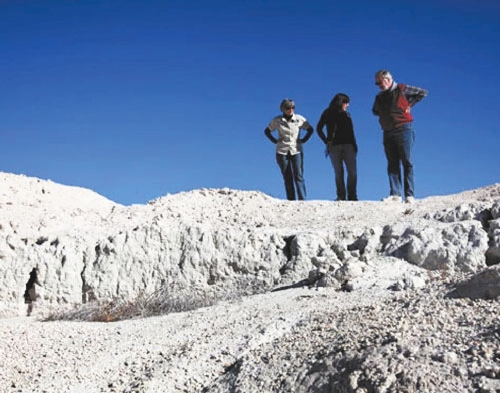Tule Springs preservation is centerpiece of sweeping lands bill
WASHINGTON - The fertile fossil beds and rare plants dotting swaths of federal land on the northern outskirts of the Las Vegas Valley would be granted long-sought protections under a bill introduced Wednesday by Nevada lawmakers in Congress.
The set-aside of 22,650 acres into what would be known as the Tule Springs Fossil Beds National Monument is the centerpiece of a sweeping public lands bill that also would expand conservation areas of Red Rock Canyon.
Nevada's newest - and only - national monument would border the cities of Las Vegas and North Las Vegas, the Las Vegas Paiute Indian Reservation and the Desert National Wildlife Refuge.
The sawtooth-shaped patch of desert is littered with the bones of mammoths and other extinct animals that lived and died between 10,000 and 100,000 years ago.
"We're out there collecting fossils every day," geologist and paleontologist Kathleen Springer said. "There's fossils falling out of the ground."
A handful of other Clark County land initiatives - some new and some that have otherwise languished in Congress - are packaged into the proposed legislation.
At the same time, the bill would make available blocks of land for development within Las Vegas and North Las Vegas, and release 10,240 acres along Sunrise Mountain that had been tied up in studies as possible wilderness.
All told, the Las Vegas Valley Lands and Tule Springs Fossil Beds National Monument Act is the broadest effort to shape the boundaries of the valley since enactment of a Clark County public lands law in 2002, which designated 440,000 acres of wilderness and created a national conservation area at Sloan Canyon.
"It provides for balanced development and job creation within the Las Vegas Valley, while protecting vital natural and scientific resources that should be made more accessible for the public's enjoyment and education," said Sen. Harry Reid, who introduced the bill with Sen. Dean Heller.
Heller said the proposal is balanced between conservation and potential development, a key mix that was necessary to move the bill through Congress.
"The goals are to protect unique areas, while planning for critical infrastructure that will be necessary to meet the future needs of the Las Vegas Valley," Heller said.
The bill's path through a Congress in the six months or so that remain in this year's session could be tenuous, although Reid could use his influence as Senate majority leader to move it along.
Rep. Shelley Berkley was introducing the same bill in the House.
Among its elements the bill does the following:
■ Designates national monument land at Tule Springs and the Upper Las Vegas Wash, securing under National Park Service control an area prized by ecologists for its rich ice age fossil beds and the presence of three rare plants native to the Mojave Desert - the Las Vegas bearpoppy, Merriam's bearpoppy and the Las Vegas buckwheat.
■ Expands the Red Rock Canyon National Conservation Area by 1,530 acres at the northwest corner of the valley.
■ Conveys 640 acres of federal land to the city of Las Vegas and 640 acres to North Las Vegas to establish "job creation zones."
■ Releases 10,240 acres along Sunrise Mountain that had been under study by the Bureau of Land Management but was rejected as possible wilderness.
■ Conveys 1,200 acres within the BLM's Nellis Dunes Recreation Area to Clark County to be transformed into a park for off-roaders.
■ Grants 2,085 acres to UNLV for a new North Las Vegas campus and gives the College of Southern Nevada 40 acres in northwest Las Vegas, while Great Basin College would obtain 280 acres in Pahrump.
The higher education acreage would be used to expand current operations. UNLV has long-term plans to develop the North Las Vegas land, perhaps focusing research operations there. President Neal Smatresk said Wednesday that, if the deal goes through, it probably would be developed over a decades-long period. There is little need and nearly no money to do so right now.
Back at Tule Springs, research has turned up the bones of mammoths, horses, camels, bison, North American lions and ground sloths the size of grizzly bears scattered through a deposit that covers a sizeable portion of the Las Vegas Valley. The proposed monument would protect the "last bastion" of that deposit from urban development, Springer said.
"I tell people, 'Look at your backyard. Your house was built on this stuff.' "
Springer is senior curator of geologic sciences at San Bernardino County Museum in California. Since 2001, she has led a team that has collected thousands of fossils from the upper Las Vegas Wash. Last year, she and her crew pulled more than 500 bones from a single spot - the highest concentration of fossils yet found in an area paleontologists have explored since the 1960s.
"We called it a super quarry," Springer said of the site. "It was like mammoth heaven."
The entire Tule Springs area provides a unique window into a vast swath of time.
"This site recounts the ice ages, the waxing and waning of water, and how the animals responded," Springer said. "The climate change aspect of this is crucial."
Sandy Croteau is one of the founding members of the Protectors of Tule Springs, a small volunteer group formed about five years ago to keep the fossil beds from being trashed or covered in homes.
"This is a big thing for the state of Nevada, for our country and for the next generations to come," she said of the bill. "It's been a long time coming."
Right now, the land in question is closed to vehicle traffic without a permit from the BLM. Approval as a national monument would launch a planning process through which valley residents will help shape how the public accesses the area, said Lynn Davis, Nevada program manager for the National Parks Conservation Association.
The monument should have no trouble drawing tourists, thanks to its scientific importance and its proximity to one of the world's most popular tourist destinations, Davis said.
"We believe this can be a model for an urban national park. You've got some priceless resources there, and the public is going to watch them being uncovered," she said.
Springer and her museum colleagues are excited about the educational possibilities. The site lends itself to becoming an open-air classroom where people young and old can watch as the bones of ancient animals are collected and examined.
"Our brains are exploding with all the awesome things we can do for the public," she said.
But advocates didn't get everything they wanted from the bill.
Davis and company said they were disappointed by the inclusion of a transmission corridor that could allow NV Energy to build a new power line across the proposed monument.
Rob Mrowka from the Nevada office of the Center for Biological Diversity called the power line corridor "a blemish" on legislation that is otherwise "wonderful news for the valley" - at least the parts of the bill concerning Tule Springs.
Review-Journal writer Richard Lake contributed to this report. Contact Stephens Washington Bureau Chief Steve Tetreault at stetreault@stephensmedia.com or 202-783-1760. Contact reporter Henry Brean at hbrean@reviewjournal.com or 702-383-0350.
Tule Springs bill





























